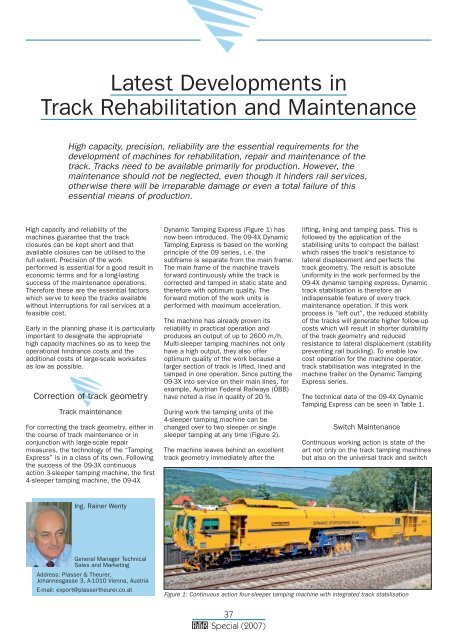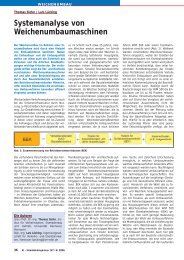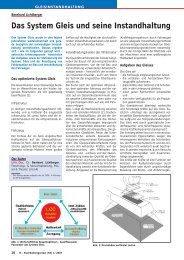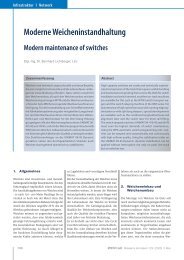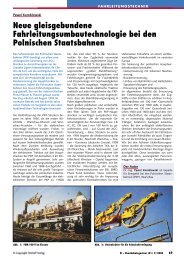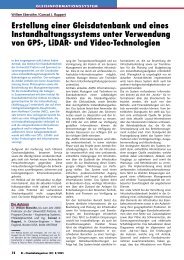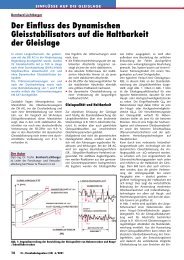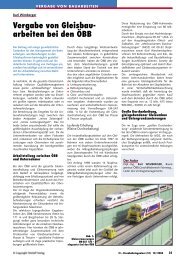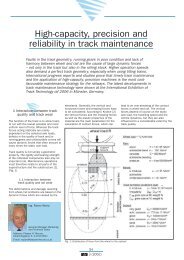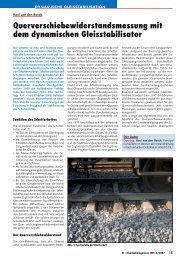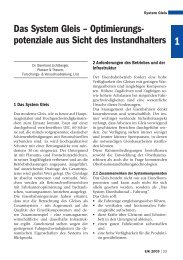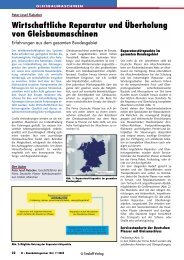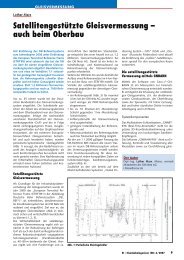Latest Developments in Track Rehabilitation ... - Plasser & Theurer
Latest Developments in Track Rehabilitation ... - Plasser & Theurer
Latest Developments in Track Rehabilitation ... - Plasser & Theurer
Create successful ePaper yourself
Turn your PDF publications into a flip-book with our unique Google optimized e-Paper software.
<strong>Latest</strong> <strong>Developments</strong> <strong>in</strong><br />
<strong>Track</strong> <strong>Rehabilitation</strong> and Ma<strong>in</strong>tenance<br />
High capacity, precision, reliability are the essential requirements for the<br />
development of mach<strong>in</strong>es for rehabilitation, repair and ma<strong>in</strong>tenance of the<br />
track. <strong>Track</strong>s need to be available primarily for production. However, the<br />
ma<strong>in</strong>tenance should not be neglected, even though it h<strong>in</strong>ders rail services,<br />
otherwise there will be irreparable damage or even a total failure of this<br />
essential means of production.<br />
High capacity and reliability of the<br />
mach<strong>in</strong>es guarantee that the track<br />
closures can be kept short and that<br />
available closures can be utilised to the<br />
full extent. Precision of the work<br />
performed is essential for a good result <strong>in</strong><br />
economic terms and for a long-last<strong>in</strong>g<br />
success of the ma<strong>in</strong>tenance operations.<br />
Therefore these are the essential factors<br />
which serve to keep the tracks available<br />
without <strong>in</strong>terruptions for rail services at a<br />
feasible cost.<br />
Early <strong>in</strong> the plann<strong>in</strong>g phase it is particularly<br />
important to designate the appropriate<br />
high capacity mach<strong>in</strong>es so as to keep the<br />
operational h<strong>in</strong>drance costs and the<br />
additional costs of large-scale worksites<br />
as low as possible.<br />
Correction of track geometry<br />
<strong>Track</strong> ma<strong>in</strong>tenance<br />
For correct<strong>in</strong>g the track geometry, either <strong>in</strong><br />
the course of track ma<strong>in</strong>tenance or <strong>in</strong><br />
conjunction with large-scale repair<br />
measures, the technology of the “Tamp<strong>in</strong>g<br />
Express” is <strong>in</strong> a class of its own. Follow<strong>in</strong>g<br />
the success of the 09-3X cont<strong>in</strong>uous<br />
action 3-sleeper tamp<strong>in</strong>g mach<strong>in</strong>e, the first<br />
4-sleeper tamp<strong>in</strong>g mach<strong>in</strong>e, the 09-4X<br />
Dynamic Tamp<strong>in</strong>g Express (Figure 1) has<br />
now been <strong>in</strong>troduced. The 09-4X Dynamic<br />
Tamp<strong>in</strong>g Express is based on the work<strong>in</strong>g<br />
pr<strong>in</strong>ciple of the 09 series, i. e. the<br />
subframe is separate from the ma<strong>in</strong> frame.<br />
The ma<strong>in</strong> frame of the mach<strong>in</strong>e travels<br />
forward cont<strong>in</strong>uously while the track is<br />
corrected and tamped <strong>in</strong> static state and<br />
therefore with optimum quality. The<br />
forward motion of the work units is<br />
performed with maximum acceleration.<br />
The mach<strong>in</strong>e has already proven its<br />
reliability <strong>in</strong> practical operation and<br />
produces an output of up to 2600 m/h.<br />
Multi-sleeper tamp<strong>in</strong>g mach<strong>in</strong>es not only<br />
have a high output, they also offer<br />
optimum quality of the work because a<br />
larger section of track is lifted, l<strong>in</strong>ed and<br />
tamped <strong>in</strong> one operation. S<strong>in</strong>ce putt<strong>in</strong>g the<br />
09-3X <strong>in</strong>to service on their ma<strong>in</strong> l<strong>in</strong>es, for<br />
example, Austrian Federal Railways (ÖBB)<br />
have noted a rise <strong>in</strong> quality of 20 %.<br />
Dur<strong>in</strong>g work the tamp<strong>in</strong>g units of the<br />
4-sleeper tamp<strong>in</strong>g mach<strong>in</strong>e can be<br />
changed over to two sleeper or s<strong>in</strong>gle<br />
sleeper tamp<strong>in</strong>g at any time (Figure 2).<br />
The mach<strong>in</strong>e leaves beh<strong>in</strong>d an excellent<br />
track geometry immediately after the<br />
lift<strong>in</strong>g, l<strong>in</strong><strong>in</strong>g and tamp<strong>in</strong>g pass. This is<br />
followed by the application of the<br />
stabilis<strong>in</strong>g units to compact the ballast<br />
which raises the track‘s resistance to<br />
lateral displacement and perfects the<br />
track geometry. The result is absolute<br />
uniformity <strong>in</strong> the work performed by the<br />
09-4X dynamic tamp<strong>in</strong>g express. Dynamic<br />
track stabilisation is therefore an<br />
<strong>in</strong>dispensable feature of every track<br />
ma<strong>in</strong>tenance operation. If this work<br />
process is “left out”, the reduced stability<br />
of the tracks will generate higher follow-up<br />
costs which will result <strong>in</strong> shorter durability<br />
of the track geometry and reduced<br />
resistance to lateral displacement (stability<br />
prevent<strong>in</strong>g rail buckl<strong>in</strong>g). To enable low<br />
cost operation for the mach<strong>in</strong>e operator,<br />
track stabilisation was <strong>in</strong>tegrated <strong>in</strong> the<br />
mach<strong>in</strong>e trailer on the Dynamic Tamp<strong>in</strong>g<br />
Express series.<br />
The technical data of the 09-4X Dynamic<br />
Tamp<strong>in</strong>g Express can be seen <strong>in</strong> Table 1.<br />
Switch Ma<strong>in</strong>tenance<br />
Cont<strong>in</strong>uous work<strong>in</strong>g action is state of the<br />
art not only on the track tamp<strong>in</strong>g mach<strong>in</strong>es<br />
but also on the universal track and switch<br />
Ing. Ra<strong>in</strong>er Wenty<br />
General Manager Technical<br />
Sales and Market<strong>in</strong>g<br />
Address: <strong>Plasser</strong> & <strong>Theurer</strong>,<br />
Johannesgasse 3, A-1010 Vienna, Austria<br />
E-mail: export@plassertheurer.co.at<br />
Figure 1: Cont<strong>in</strong>uous action four-sleeper tamp<strong>in</strong>g mach<strong>in</strong>e with <strong>in</strong>tegrated track stabilisation<br />
37<br />
Special (2007)
<strong>Latest</strong> <strong>Developments</strong> <strong>in</strong> <strong>Track</strong> <strong>Rehabilitation</strong> and Ma<strong>in</strong>tenance<br />
Figures 2: Work positions of the four-sleeper tamp<strong>in</strong>g unit<br />
four-sleeper tamp<strong>in</strong>g two-sleeper tamp<strong>in</strong>g s<strong>in</strong>gle-sleeper tamp<strong>in</strong>g<br />
Total mass<br />
Length over buffers<br />
Height over top of rail<br />
Width<br />
Distance between bogie pivots<br />
Bogie 1 – bogie 3<br />
Bogie 3 – bogie 4<br />
Bogie 4 – bogie 5<br />
Eng<strong>in</strong>e output<br />
Tamp<strong>in</strong>g mach<strong>in</strong>e<br />
Power unit and stabilis<strong>in</strong>g car<br />
Travell<strong>in</strong>g speed<br />
under own power/towed, max.<br />
approx. 158 t<br />
34040 mm<br />
4200 mm<br />
2900 mm<br />
17 300 mm<br />
5 600 mm<br />
12 000 mm<br />
440 kW<br />
440 kW<br />
100/120 km/h<br />
Table 1: Technical<br />
data of 09-4X Dynamic<br />
Tamp<strong>in</strong>g Express<br />
passes are necessary <strong>in</strong> the course of track<br />
lay<strong>in</strong>g or track ma<strong>in</strong>tenance operations,<br />
survey<strong>in</strong>g must be carried out shortly<br />
beforehand, that is to say, just ahead of the<br />
mach<strong>in</strong>e. The CAL laser system for curves,<br />
which measures the vers<strong>in</strong>es and fixed<br />
po<strong>in</strong>ts with the help of a laser front trolley<br />
and a receiver on the mach<strong>in</strong>e, was<br />
developed for this purpose. The CAL-SAT,<br />
shown <strong>in</strong> Figure 3 together with the Unimat,<br />
is a further development of this system,<br />
offer<strong>in</strong>g the operator a protected workplace.<br />
Ballast management<br />
tamp<strong>in</strong>g mach<strong>in</strong>es. With the Unimat<br />
09-32/4S Dynamic the development is<br />
already so far advanced that two sleepers<br />
can be treated <strong>in</strong> each work cycle with<br />
3-rail lift<strong>in</strong>g and 4-rail tamp<strong>in</strong>g. Like on the<br />
Tamp<strong>in</strong>g Express, the track stabilis<strong>in</strong>g<br />
units are <strong>in</strong>corporated <strong>in</strong> the mach<strong>in</strong>e<br />
trailer and can be applied not only <strong>in</strong> the<br />
track but also <strong>in</strong> the switches.<br />
The newly developed Unimat 09-475 4S is<br />
a cont<strong>in</strong>uous action s<strong>in</strong>gle sleeper tamp<strong>in</strong>g<br />
mach<strong>in</strong>e for tracks and switches now<br />
operat<strong>in</strong>g <strong>in</strong> Austria. This mach<strong>in</strong>e is built<br />
<strong>in</strong> compact design and offers good value<br />
for money (Figure 3).<br />
On high-capacity tracks and switches it is<br />
absolutely necessary to perform track<br />
geometry corrections us<strong>in</strong>g the precision<br />
method and not only the compensation<br />
method. Two to six weeks before the<br />
tamp<strong>in</strong>g mach<strong>in</strong>e is scheduled, the EM-SAT<br />
is deployed to carry out a laser-assisted<br />
track geometry survey to determ<strong>in</strong>e the<br />
deviations from the target track geometry<br />
together with the lift<strong>in</strong>g and displacement<br />
values. If several consecutive tamp<strong>in</strong>g<br />
Figure 3: Cont<strong>in</strong>uous<br />
action switch tamp<strong>in</strong>g<br />
mach<strong>in</strong>e with measur<strong>in</strong>g<br />
trolley (CAL-SAT)<br />
The optimum ballast cross-section is of<br />
great importance for the safety of the track<br />
geometry aga<strong>in</strong>st track buckl<strong>in</strong>g and for<br />
the durability of the track geometry itself.<br />
Too much ballast <strong>in</strong> the track causes<br />
unnecessary h<strong>in</strong>drances and costs when<br />
perform<strong>in</strong>g ma<strong>in</strong>tenance. Too little ballast<br />
reduces the stability of the track and gives<br />
rise to faults <strong>in</strong> the track geometry. There<br />
is around 3000 to 5000 m 3 of ballast <strong>in</strong><br />
every kilometre of a double-track l<strong>in</strong>e<br />
depend<strong>in</strong>g upon the type of track and track<br />
spac<strong>in</strong>g. The cost-efficient handl<strong>in</strong>g and<br />
management of these enormous quantities<br />
of material presents a great challenge for<br />
track ma<strong>in</strong>tenance eng<strong>in</strong>eers.<br />
On most ma<strong>in</strong> l<strong>in</strong>es there is sufficient<br />
good ballast available but it is often<br />
distributed unevenly. Ballast profile<br />
measurements on the ÖBB us<strong>in</strong>g the<br />
EM-SAT have confirmed this impression.<br />
If the exist<strong>in</strong>g ballast <strong>in</strong> the track could be<br />
distributed uniformly, it would be possible<br />
to save large quantities of new ballast <strong>in</strong><br />
conjunction with track ma<strong>in</strong>tenance<br />
operations.<br />
This f<strong>in</strong>d<strong>in</strong>g has led to the fact that s<strong>in</strong>ce<br />
2005 the ÖBB has been us<strong>in</strong>g two BDS<br />
38<br />
Special (2007)
<strong>Latest</strong> <strong>Developments</strong> <strong>in</strong> <strong>Track</strong> <strong>Rehabilitation</strong> and Ma<strong>in</strong>tenance<br />
2000 systems <strong>in</strong> conjunction with the<br />
mechanised ma<strong>in</strong>tenance tra<strong>in</strong>s (Figure 4).<br />
These ballast distribut<strong>in</strong>g and profil<strong>in</strong>g<br />
mach<strong>in</strong>es have a powerful ballast pick-up<br />
system to collect surplus ballast from the<br />
track and store it <strong>in</strong> a large hopper. The<br />
mach<strong>in</strong>e has two sweeper and collect<strong>in</strong>g<br />
units positioned one beh<strong>in</strong>d the other to<br />
be able to keep pace with the high-capacity<br />
mach<strong>in</strong>es of the Tamp<strong>in</strong>g Express series. If<br />
a great deal of ballast has to be stored,<br />
the system can be extended at any time by<br />
add<strong>in</strong>g MFS material conveyor and hopper<br />
units. In conjunction with the ballast profile<br />
measurement developed by <strong>Plasser</strong> &<br />
<strong>Theurer</strong> us<strong>in</strong>g the EM-SAT survey car,<br />
metered quantities of ballast can be<br />
returned to the track wherever there is too<br />
little. With consistent application of the<br />
mach<strong>in</strong>e to save ballast, and only used <strong>in</strong><br />
conjunction with track ma<strong>in</strong>tenance, the<br />
mach<strong>in</strong>e can pay for itself with<strong>in</strong> a period<br />
of two years.<br />
On high-speed l<strong>in</strong>es it is particularly<br />
important to carry out thorough sweep<strong>in</strong>g<br />
of the sleeper surfaces and the sleeper<br />
cribs <strong>in</strong> order to prevent ballast stones<br />
swirl<strong>in</strong>g up due to the high speeds. For this<br />
reason, the ÖBB – and many other railways<br />
– specify so-called „deep sweep<strong>in</strong>g“<br />
wherever speeds over 200 km/h are<br />
permitted. In this case the BDS sweeps<br />
the ballast out of the sleeper cribs 4 to<br />
6 cm below the top of the sleeper.<br />
The front section of the mach<strong>in</strong>e is fitted<br />
with ballast distribut<strong>in</strong>g devices for exact<br />
placement of the ballast, the plough for<br />
work on the ballast crown and the two<br />
shoulder ploughs. The <strong>in</strong>tegrated ballast<br />
hopper has a storage capacity of approx.<br />
20 m 3 .<br />
Only profil<strong>in</strong>g mach<strong>in</strong>es <strong>in</strong> heavy-duty<br />
design can shift large quantities of ballast<br />
<strong>in</strong> one pass, a pr<strong>in</strong>ciple that was first<br />
made possible <strong>in</strong> the SSP series and today<br />
has been perfected <strong>in</strong> the mach<strong>in</strong>es of the<br />
SSP series and USP 2010. The cont<strong>in</strong>uous<br />
work<strong>in</strong>g action dur<strong>in</strong>g ballast profil<strong>in</strong>g has<br />
also become reality <strong>in</strong> the BDS system.<br />
The ballast profil<strong>in</strong>g devices themselves<br />
consist of steplessly adjustable shoulder<br />
ploughs, followed by an X plough for work<br />
on the ballast crown. Due to this<br />
comb<strong>in</strong>ation, ballast can be displaced from<br />
one side to the other <strong>in</strong> one pass and the<br />
X plough enables exact placement on the<br />
ballast crown and especially <strong>in</strong> the tamp<strong>in</strong>g<br />
zone. The sweeper units follow<strong>in</strong>g beh<strong>in</strong>d<br />
have rotat<strong>in</strong>g brushes (fitted with rubber<br />
hoses or rubber elements) with a large<br />
diameter, which is a basic requirement to<br />
achieve a high sweep<strong>in</strong>g output.<br />
Ballast bed clean<strong>in</strong>g<br />
The ballast bed fulfils an important<br />
function <strong>in</strong> the track system as a loaddistribut<strong>in</strong>g<br />
and shock-absorb<strong>in</strong>g element.<br />
It must also be water permeable <strong>in</strong> order<br />
to ensure good dra<strong>in</strong>age. These properties<br />
are present only when there is not too<br />
much f<strong>in</strong>e material <strong>in</strong> the ballast, that is to<br />
say, when pollution of the track bed is at a<br />
reasonable level.<br />
However, <strong>in</strong> the course of time, traffic<br />
load<strong>in</strong>g and environmental <strong>in</strong>fluences<br />
cause f<strong>in</strong>e material to be deposited <strong>in</strong> the<br />
ballast bed which generally builds up from<br />
the formation upwards and is largest <strong>in</strong><br />
the carry<strong>in</strong>g area under the sleepers<br />
(Figure 5). On poor subsoil there is also<br />
the ris<strong>in</strong>g of cohesive material. Tamp<strong>in</strong>g,<br />
on the other hand, scarcely contributes<br />
towards the formation of f<strong>in</strong>e gra<strong>in</strong>; ballast<br />
Figure 4: Mach<strong>in</strong>e<br />
system for ballast<br />
management<br />
f<strong>in</strong>es of only around 2.5 to 4 kg are<br />
generated per tamp<strong>in</strong>g cycle and sleeper.<br />
That is equivalent to 25 to 80 kg (10 to 20<br />
tamp<strong>in</strong>g cycles) for the life cycle of a track<br />
– a very small quantity <strong>in</strong> comparison to<br />
the entire ballast volume.<br />
If the ballast bed is polluted, it will not be<br />
possible to achieve any long-last<strong>in</strong>g track<br />
geometry and the track materials wear out<br />
prematurely due to the <strong>in</strong>creased moisture<br />
and the higher dynamic forces. Studies<br />
carried out by ERRI have shown that this<br />
condition occurs as soon as more than<br />
30 % of the ballast has a diameter smaller<br />
than 22.5 mm. When such a degree of<br />
pollution has been reached, ballast<br />
clean<strong>in</strong>g is recommended and this is<br />
absolutely necessary when this figure is<br />
higher than 40 %. The decid<strong>in</strong>g criterion for<br />
the necessity of ballast clean<strong>in</strong>g is ma<strong>in</strong>ly<br />
the track geometry deterioration <strong>in</strong> the<br />
course of time and modern track data<br />
banks supply the respective data and<br />
evaluations.<br />
Ballast clean<strong>in</strong>g is a cost-<strong>in</strong>tensive<br />
ma<strong>in</strong>tenance measure, therefore the<br />
technologically correct execution is very<br />
important and will save a considerable<br />
Figure 5: <strong>Track</strong> ballast<br />
after 27 years of<br />
operation with approx.<br />
500 million load tons<br />
39<br />
Special (2007)
<strong>Latest</strong> <strong>Developments</strong> <strong>in</strong> <strong>Track</strong> <strong>Rehabilitation</strong> and Ma<strong>in</strong>tenance<br />
Figure 6: Ballast clean<strong>in</strong>g mach<strong>in</strong>e with triple-layer screen<strong>in</strong>g unit<br />
amount of money <strong>in</strong> the long term. Basic<br />
pr<strong>in</strong>ciples for ballast clean<strong>in</strong>g are:<br />
The ballast bed must be excavated<br />
over its entire width. If polluted clumps<br />
of ballast rema<strong>in</strong> on the shoulder, the<br />
dra<strong>in</strong>age will not function later.<br />
The ballast excavation must be<br />
performed with a straight cut to<br />
produce a formation with the correct<br />
crossfall and a uniform course <strong>in</strong><br />
longitud<strong>in</strong>al direction of the track.<br />
The entire depth of the ballast under<br />
the sleepers must be excavated<br />
because the greatest pollution is found<br />
<strong>in</strong> the lower area.<br />
Partial clean<strong>in</strong>g (for example shoulder<br />
clean<strong>in</strong>g) normally has little success,<br />
because a large proportion of the<br />
ballast attrition occurs <strong>in</strong> the area<br />
underneath the sleepers.<br />
The excavated material must be<br />
cleaned <strong>in</strong> vibration screen<strong>in</strong>g plants<br />
specially developed for track ballast,<br />
with few rema<strong>in</strong><strong>in</strong>g f<strong>in</strong>e particles and no<br />
excessive loss of usable ballast.<br />
The screened-out spoil must be<br />
evacuated to the front end so that the<br />
cleaned track is not polluted by spilled<br />
material.<br />
Re-ballast<strong>in</strong>g must be carried out evenly<br />
and allow variation of the track height.<br />
Practical construction of the<br />
RM 80 US ballast clean<strong>in</strong>g mach<strong>in</strong>e<br />
For many years the ballast clean<strong>in</strong>g<br />
mach<strong>in</strong>es of the RM 80 series have been<br />
sett<strong>in</strong>g standards for high-quality ballast<br />
clean<strong>in</strong>g with high output. The RM 80 US<br />
now operated by the ÖBB is the latest<br />
development from this series. Like all<br />
<strong>Plasser</strong> & <strong>Theurer</strong> ballast clean<strong>in</strong>g<br />
mach<strong>in</strong>es, this mach<strong>in</strong>e has a transverse<br />
cha<strong>in</strong> guide for the excavat<strong>in</strong>g cha<strong>in</strong> to<br />
produce a smooth, straight formation<br />
which can be set exactly to the required<br />
excavat<strong>in</strong>g depth and formation cross-fall.<br />
Dur<strong>in</strong>g work this can be controlled and<br />
adjusted from the workplace or<br />
automatically by the measur<strong>in</strong>g unit.<br />
These special measur<strong>in</strong>g and monitor<strong>in</strong>g<br />
units consist of roller transducers, an<br />
electronic pendulum, the process<strong>in</strong>g<br />
electronics and display <strong>in</strong>struments <strong>in</strong> the<br />
work cab<strong>in</strong>. The constant angle of the cha<strong>in</strong><br />
cutter bar is adjusted automatically with<br />
the help of the electronic pendulum. An<br />
optional rotation laser transmitter, which is<br />
set up at a distance of up to 300 metres,<br />
produces a laser beam sight<strong>in</strong>g plane<br />
which hits the laser receiver (mounted on<br />
the outer side of the cutter bar). This laser<br />
unit performs automatic control of the<br />
excavation depth of the excavat<strong>in</strong>g cha<strong>in</strong> to<br />
produce a straight formation.<br />
A six-channel recorder is available for<br />
exact monitor<strong>in</strong>g of the work<strong>in</strong>g quality<br />
which records the ma<strong>in</strong> parameters:<br />
excavation depth, formation crossfall,<br />
superelevation of the old track and of the<br />
cleaned track, twist of the cleaned track<br />
as well as track height and track lower<strong>in</strong>g.<br />
Excavation to a width of 7700 mm and a<br />
depth of 1000 mm enables ballast clean<strong>in</strong>g<br />
<strong>in</strong> switches without hav<strong>in</strong>g to dismantle the<br />
switch. The excavat<strong>in</strong>g width can be varied<br />
by <strong>in</strong>sert<strong>in</strong>g <strong>in</strong>termediate l<strong>in</strong>ks 500 mm<br />
wide <strong>in</strong> the cutter bar. Snap closures enable<br />
fast execution of this work. The four speed<br />
sett<strong>in</strong>gs of the cha<strong>in</strong> allow ideal adaptation<br />
to different ballast situations.<br />
The triple-layer screen<strong>in</strong>g unit of the RM<br />
80 US has been optimised with regard to<br />
screen angle, mesh size and vibration, is<br />
40<br />
Special (2007)<br />
equipped with large-stone separation and<br />
achieves excellent results. The automatic<br />
superelevation compensation prevents<br />
one-sided distribution of the material on<br />
the screen surfaces.<br />
Frequently it is necessary to add new<br />
ballast, due to the high percentage of<br />
spoil. The RM 80 US not only places the<br />
cleaned ballast com<strong>in</strong>g from the screen<strong>in</strong>g<br />
unit evenly <strong>in</strong> the track us<strong>in</strong>g hydraulically<br />
adjustable baffles and slew<strong>in</strong>g distribut<strong>in</strong>g<br />
conveyor belts, but also distributes new<br />
ballast via ballast chutes directly <strong>in</strong> the<br />
track, with an optional new ballast supply<br />
unit.<br />
The spoil is loaded <strong>in</strong>to MFS material<br />
conveyor and hopper units stand<strong>in</strong>g at the<br />
front us<strong>in</strong>g a slew<strong>in</strong>g spoil conveyor belt <strong>in</strong><br />
the area where the ballast has not yet<br />
been cleaned, or the spoil material is<br />
deposited at the side of the track. To<br />
ensure that overhangs and visibility comply<br />
with UIC regulations, the RM 80 US was<br />
equipped with a third cab<strong>in</strong> which supports<br />
the transfer conveyor belt for the spoil. For<br />
work<strong>in</strong>g movements this mach<strong>in</strong>e is <strong>in</strong><br />
articulated design.<br />
The new output category<br />
RM 800 Super 3S<br />
Essentially the output capacity of a ballast<br />
clean<strong>in</strong>g mach<strong>in</strong>e is determ<strong>in</strong>ed by the size<br />
of the screen<strong>in</strong>g unit and the excavat<strong>in</strong>g<br />
cha<strong>in</strong>. In 1989 the RM 800 was the first<br />
ballast clean<strong>in</strong>g mach<strong>in</strong>e to be built with two<br />
screen<strong>in</strong>g units and one excavat<strong>in</strong>g cha<strong>in</strong><br />
steplessly adjustable to the excavat<strong>in</strong>g<br />
width. Outputs of up to 1000 m 3 /h were<br />
achieved. This concept has prevailed and<br />
today mach<strong>in</strong>es with a double screen<strong>in</strong>g unit<br />
are already standard equipment on many
<strong>Latest</strong> <strong>Developments</strong> <strong>in</strong> <strong>Track</strong> <strong>Rehabilitation</strong> and Ma<strong>in</strong>tenance<br />
railways because they enable full utilisation<br />
of the track possessions.<br />
Due to the dense traffic situation on highspeed<br />
l<strong>in</strong>es, even higher outputs will be<br />
needed <strong>in</strong> the future and this requirement<br />
will be met by a new category of mach<strong>in</strong>es<br />
fitted with three screen<strong>in</strong>g units.<br />
The RM 800 Super 3 S (Figure 6) is a<br />
fully hydraulically powered multi-car<br />
mach<strong>in</strong>e with 10 powered axles consist<strong>in</strong>g<br />
of drive unit, screen<strong>in</strong>g car, excavat<strong>in</strong>g car,<br />
power unit and tank and measur<strong>in</strong>g trailer.<br />
All cars, except the tank and measur<strong>in</strong>g<br />
trailer, are l<strong>in</strong>ked together by pivot<br />
coupl<strong>in</strong>g. The mach<strong>in</strong>e consists of the<br />
follow<strong>in</strong>g sections:<br />
Drive unit with conveyor belts for spoil,<br />
slew<strong>in</strong>g spoil transfer conveyor belt that<br />
can also be turned for transit, one drive<br />
eng<strong>in</strong>e, diesel and water tanks, cab<strong>in</strong> at<br />
front and measur<strong>in</strong>g axles to measure the<br />
track geometry before clean<strong>in</strong>g.<br />
Screen<strong>in</strong>g car with three eccentric<br />
vibrat<strong>in</strong>g screens, conveyor belts for<br />
excavated material, cleaned ballast and<br />
spoil.<br />
Excavat<strong>in</strong>g car with endless excavat<strong>in</strong>g<br />
cha<strong>in</strong>, fully adjustable excavat<strong>in</strong>g width up<br />
to 5330 mm (with feeder plates), track<br />
lift<strong>in</strong>g and slew<strong>in</strong>g devices, conveyor belts<br />
for transport of excavated material to<br />
screen<strong>in</strong>g car, return transport of cleaned<br />
ballast, ballast hopper for cleaned ballast,<br />
ballast distribut<strong>in</strong>g conveyor belt and<br />
profil<strong>in</strong>g plough, cab<strong>in</strong> <strong>in</strong> front of the<br />
excavat<strong>in</strong>g cha<strong>in</strong> and beh<strong>in</strong>d the ballast<br />
distribut<strong>in</strong>g and profil<strong>in</strong>g devices.<br />
Power unit with two drive eng<strong>in</strong>es.<br />
Tank and measur<strong>in</strong>g trailer carry<strong>in</strong>g three<br />
diesel tanks and measur<strong>in</strong>g axles to<br />
measure track geometry after clean<strong>in</strong>g.<br />
Cab<strong>in</strong> with driver‘s control desk, workshop<br />
cab<strong>in</strong> and measur<strong>in</strong>g recorder.<br />
Measur<strong>in</strong>g, guid<strong>in</strong>g and record<strong>in</strong>g devices<br />
plot the parameters excavat<strong>in</strong>g depth,<br />
formation crossfall, vers<strong>in</strong>e and<br />
superelevation, twist and lower<strong>in</strong>g of the<br />
cleaned track.<br />
Another mach<strong>in</strong>e with three screen<strong>in</strong>g<br />
units and two excavat<strong>in</strong>g cha<strong>in</strong>s, the<br />
RMW 1500, has been operat<strong>in</strong>g<br />
successfully <strong>in</strong> Germany s<strong>in</strong>ce 2005.<br />
Comb<strong>in</strong>ation of ballast bed<br />
clean<strong>in</strong>g and track renewal<br />
In order to utilise track possessions as<br />
fully as possible the trend is go<strong>in</strong>g towards<br />
comb<strong>in</strong>ation mach<strong>in</strong>es which means that<br />
several stages of work are comb<strong>in</strong>ed <strong>in</strong><br />
one mach<strong>in</strong>e. <strong>Track</strong> renewal and ballast<br />
bed clean<strong>in</strong>g are nearly always carried out<br />
as a jo<strong>in</strong>t project because the new<br />
permanent way material should be<br />
<strong>in</strong>stalled on a perfect track bed. Up until<br />
now these jobs were performed <strong>in</strong> two<br />
separate operations us<strong>in</strong>g high-capacity<br />
mach<strong>in</strong>es and frequently it was necessary<br />
to perform a stabilisation tamp<strong>in</strong>g pass<br />
between ballast clean<strong>in</strong>g and track renewal<br />
<strong>in</strong> order to allow the track to be re-opened<br />
for traffic <strong>in</strong> between. The RU 800 S is the<br />
world‘s first comb<strong>in</strong>ation mach<strong>in</strong>e for<br />
cont<strong>in</strong>uous track renewal and<br />
simultaneous ballast bed clean<strong>in</strong>g with<br />
supply of new ballast.<br />
Composition and function<br />
of the RU 800 S<br />
The heart of the mach<strong>in</strong>e is the actual<br />
track renewal mach<strong>in</strong>e with <strong>in</strong>tegrated<br />
ballast bed clean<strong>in</strong>g (Figure 7). Dur<strong>in</strong>g<br />
work the middle bogie is raised by turn<strong>in</strong>g<br />
a sp<strong>in</strong>dle and the two four-axled bogies are<br />
displaced by 4.5 metres to the front or to<br />
the rear to obta<strong>in</strong> a clear work<strong>in</strong>g space<br />
45 m long. This free work<strong>in</strong>g space<br />
ensures a gentle bend<strong>in</strong>g l<strong>in</strong>e for the rails<br />
dur<strong>in</strong>g removal and lay<strong>in</strong>g.<br />
The old-sleeper pick-up unit lifts up the old<br />
sleepers <strong>in</strong> cont<strong>in</strong>uous work<strong>in</strong>g action and<br />
conveys them on conveyor belts to the oldsleeper<br />
transfer platform. Then the ballast<br />
is excavated us<strong>in</strong>g an excavat<strong>in</strong>g cha<strong>in</strong>.<br />
The excavat<strong>in</strong>g depth can be as much as<br />
700 mm below the top edge of the<br />
sleeper. The old ballast is carried on<br />
conveyor belts to the double screen<strong>in</strong>g<br />
unit. There the spoil is separated from the<br />
reusable ballast. After this, the cleaned<br />
and the new ballast is taken back for<br />
<strong>in</strong>sertion. A plough distributes the ballast<br />
<strong>in</strong> the ballast<strong>in</strong>g area, tak<strong>in</strong>g care that the<br />
area <strong>in</strong> the centre of the track is lower <strong>in</strong><br />
order to avoid centre-bound sleepers. Then<br />
the <strong>in</strong>serted ballast is compacted us<strong>in</strong>g<br />
41<br />
Special (2007)<br />
Figure 7: RU 800 S –<br />
pick<strong>in</strong>g up sleepers,<br />
pick<strong>in</strong>g up ballast,<br />
lay<strong>in</strong>g sleepers<br />
plate consolidators. Immediately after this,<br />
the new sleepers are placed at the correct<br />
sleeper spac<strong>in</strong>g. Due to the limited space<br />
available, the new sleepers are<br />
transported through the mach<strong>in</strong>e parallel<br />
to the track axis. For that reason the new<br />
sleepers are turned <strong>in</strong>side the mach<strong>in</strong>e, <strong>in</strong><br />
pairs, the first time after the transfer<br />
platform and the second time before the<br />
lay<strong>in</strong>g unit.<br />
The supply of new sleepers and evacuation<br />
of old sleepers is carried out by two gantry<br />
units which can pick up 30 sleepers at a<br />
time. The gantry units run on rails<br />
mounted on the sides of the cars. For<br />
transfer travel two 4-axled wagons with<br />
arched frames are used to transport the<br />
gantry units. Dur<strong>in</strong>g work the rema<strong>in</strong><strong>in</strong>g rail<br />
fasten<strong>in</strong>gs are loosened underneath the<br />
frame of the first wagon. The drive eng<strong>in</strong>es<br />
are also mounted on this wagon. The<br />
second wagon carries the measur<strong>in</strong>g<br />
equipment and a water tank.<br />
Figure 8: RU 800 S – pick<strong>in</strong>g up ballast from the<br />
shoulder
<strong>Latest</strong> <strong>Developments</strong> <strong>in</strong> <strong>Track</strong> <strong>Rehabilitation</strong> and Ma<strong>in</strong>tenance<br />
The advantages of the mach<strong>in</strong>e are the<br />
cost-efficient utilisation of track<br />
possessions due to the comb<strong>in</strong>ed<br />
execution of track renewal and ballast bed<br />
clean<strong>in</strong>g, the avoidance of “lost work<br />
passes” and the technologically correct<br />
sequence of work: clean<strong>in</strong>g before<br />
renewal. It is even possible to perform<br />
ballast clean<strong>in</strong>g <strong>in</strong> restricted areas such as<br />
station platforms. Quality and costs <strong>in</strong><br />
track renewal and track upgrad<strong>in</strong>g are<br />
further optimised thanks to the application<br />
of the RU 800 S.<br />
The shoulder excavation car (Figure 8)<br />
follows beh<strong>in</strong>d the relay<strong>in</strong>g mach<strong>in</strong>e. Two<br />
shoulder cutters pick up the rema<strong>in</strong><strong>in</strong>g<br />
ballast and pass it to conveyor belts for<br />
transport to the screen<strong>in</strong>g car. The<br />
excavat<strong>in</strong>g width of each cutter can be<br />
varied between 600 mm and 1250 mm.<br />
The ballast storage and ballast distribut<strong>in</strong>g<br />
car follow<strong>in</strong>g beh<strong>in</strong>d is equipped with a<br />
30 m 3 buffer store for new ballast and/or<br />
cleaned ballast. The floor of the hopper is<br />
designed as a conveyor belt. Ballast<br />
distribut<strong>in</strong>g devices for the shoulders and<br />
for the sleeper cribs are mounted beh<strong>in</strong>d<br />
the hopper. In addition to this, an<br />
automatic action eight-sp<strong>in</strong>dle power<br />
wrench is mounted on the ballast hopper<br />
car which is suspended on the ma<strong>in</strong> frame<br />
so that it is longitud<strong>in</strong>ally displaceable and<br />
Figure 9: RU 800 S –<br />
double screen<strong>in</strong>g unit<br />
tightens the rail fasten<strong>in</strong>gs <strong>in</strong> cyclic action.<br />
When Fastclips are used, the eight-sp<strong>in</strong>dle<br />
module is replaced before start of work by<br />
a Fastclip clipp<strong>in</strong>g unit.<br />
The ballast<strong>in</strong>g and power wrench car is<br />
followed by the screen<strong>in</strong>g car. Two<br />
eccentric vibratory screens (Figure 9) are<br />
<strong>in</strong> operation, as already used on other<br />
high-capacity ballast clean<strong>in</strong>g mach<strong>in</strong>es.<br />
The screens separate the re-usable ballast<br />
from the spoil. A total screen<strong>in</strong>g area of<br />
46 m 2 guarantees the required output.<br />
Material conveyor and hopper units are<br />
used to transport the spoil and the ballast.<br />
These are coupled to the end of the<br />
mach<strong>in</strong>e. The new-ballast MFS is equipped<br />
additionally with a conveyor belt to<br />
transport the spoil.<br />
Summary<br />
In general, decisions concern<strong>in</strong>g the<br />
project costs are made <strong>in</strong> the plann<strong>in</strong>g<br />
phase and only slight adjustments can be<br />
made <strong>in</strong> the implementation and operation<br />
phase.<br />
It is therefore very important for the<br />
plann<strong>in</strong>g eng<strong>in</strong>eer to have full <strong>in</strong>formation<br />
about cost-sav<strong>in</strong>g methods of construction<br />
and they should already be laid down <strong>in</strong><br />
the specification. This article presents<br />
newly developed mach<strong>in</strong>es and systems<br />
which are designed to improve the<br />
availability of the track for rail services.<br />
Therefore they offer high work<strong>in</strong>g speed<br />
and excellent quality and comb<strong>in</strong>e several<br />
work<strong>in</strong>g operations <strong>in</strong> one mach<strong>in</strong>e. Great<br />
attention is also given to the economical<br />
use of material resources such as track<br />
ballast.<br />
Unimat 09-475/4S<br />
42<br />
Special (2007)


